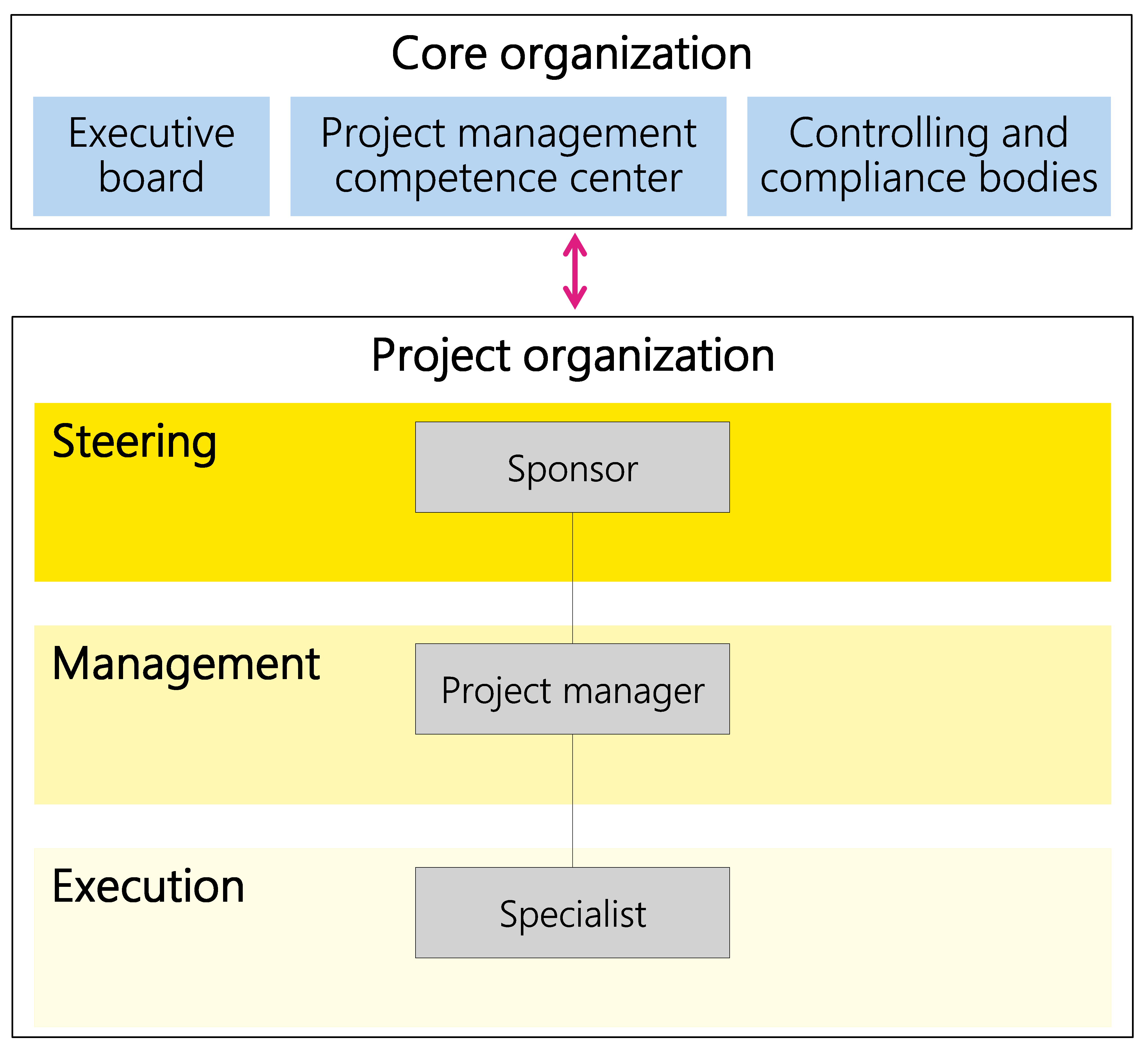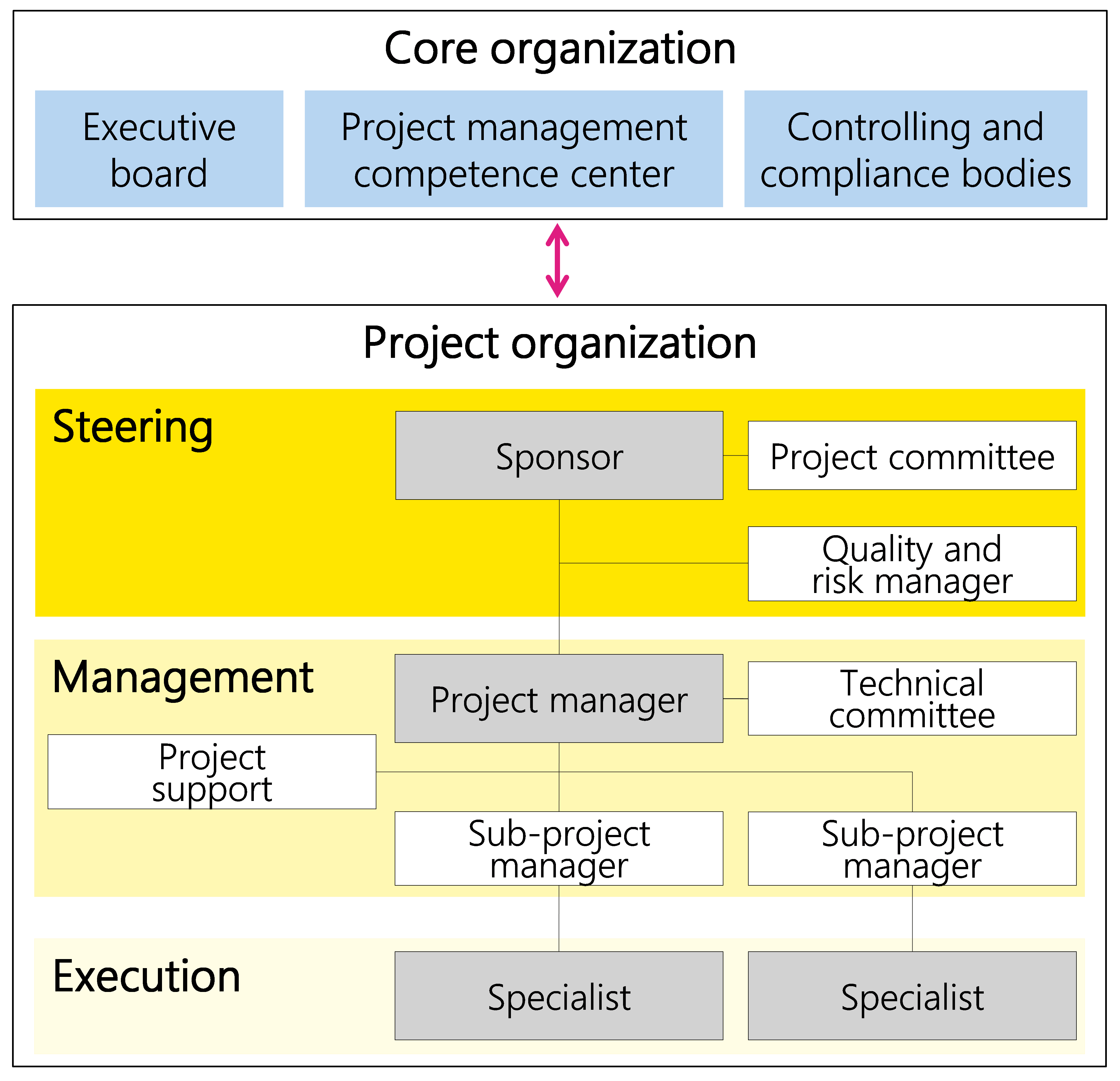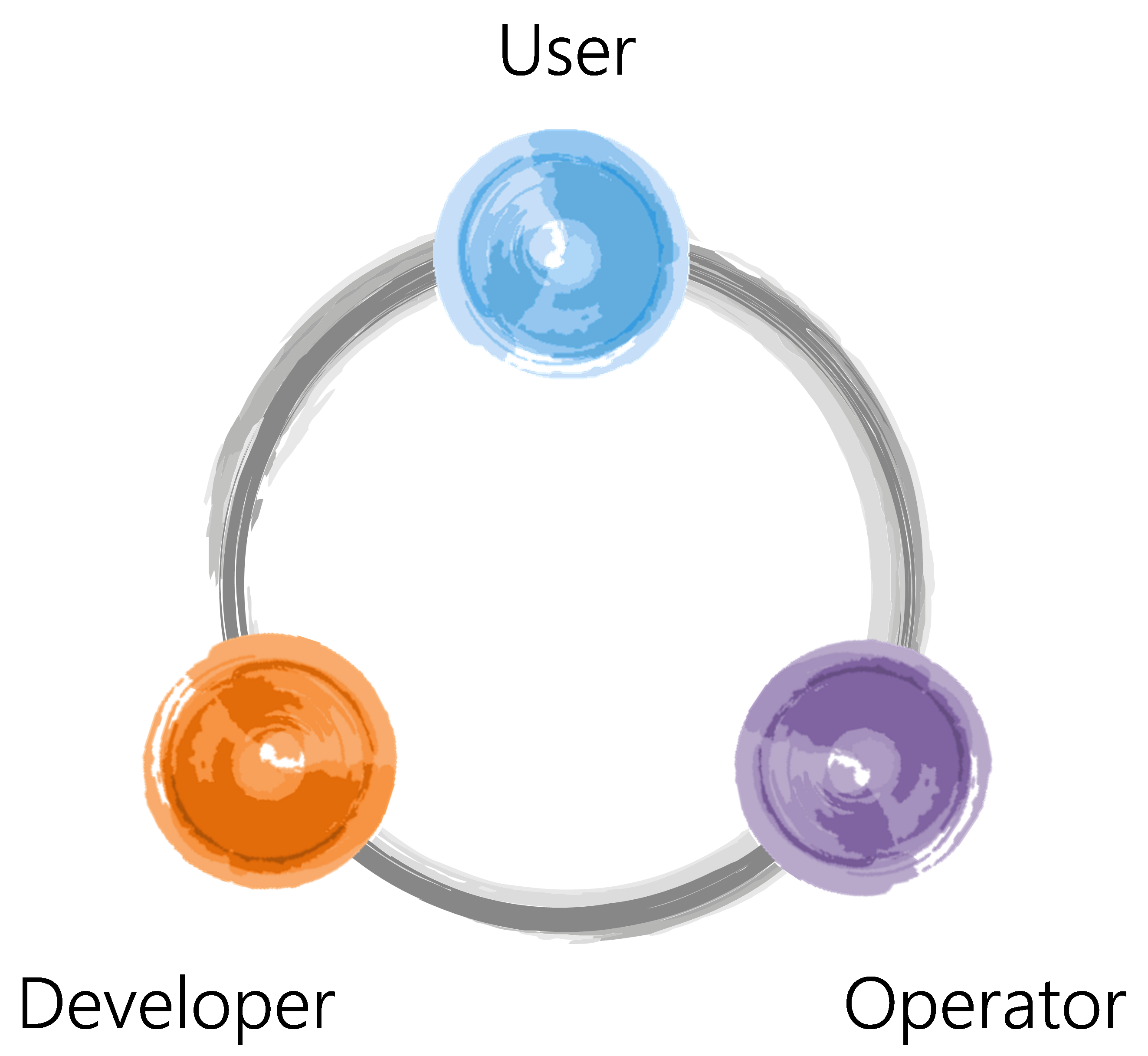Roles
Introduction
Role model
HERMES defines a role model and describes standardized roles in order to create a uniform understanding across the whole organization.
The role model distinguishes between the roles of the core organization and the roles of the project organization. Figure 21 shows a minimum project organization with the roles of project sponsor, project manager and specialist. Additional roles are used as required.

Core organization
The core organization is the organization to which the project sponsor and user belong. It is a legal entity that defines strategies and requirements for projects. The core organization provides the necessary resources (infrastructure, finances and personnel) for the project. Examples of core organizations include the Federal Administration, a cantonal administration, a city administration, an association, an enterprise.
As shown in Figure 21, three role groups are relevant for the project in the core organization:
-
Executive board
Steers the project portfolio from a strategic perspective, prioritizes projects and allocates infrastructure as well as human and financial resources to the specific project. -
Project management competence center
Provides methods, tools, coaching and other services for project management and project portfolio management. This function is also called the project management office (PMO). -
Controlling and compliance bodies
Define requirements and check compliance from an organization-wide perspective. Such bodies include financial control, auditing, IT controlling, architecture and information security and data protection bodies, for example.
The roles of the role groups listed vary depending on the core organization. Consequently, they are not described further in HERMES.
Project organization
The project organization is a temporary organization that is closely linked to the core organization. It is put into effect with the project initiation order and dissolved with the decision to close the project.
The project organization is continuously adapted to the needs of the project in the course of project execution. As the project unfolds, additional partners may join the project organization. For example, an external provider of a product is not defined until after procurement and then becomes part of the project organization.
The project organization consists of various roles (see Figure 22). They regulate the tasks, powers and responsibilities of those involved in the project. Each role is specified with a role description.
A role is assigned to one of the hierarchy levels of steering, management or execution.
-
Steering
Steers the project as a whole across the organization and ensures that the project objectives are achieved. -
Management
Draws up project foundations, leads project and employees, closes project. -
Execution
Develops project outcomes and implements quality assurance measures.
Partners in the project organization are users, creators and operators. Each role is assigned to one or more partners.

Role overview
The table gives an overview of the roles in the project organization. It also shows the assignment of each role to the hierarchy level and to the partner, and indicates the minimum roles to be filled in a project organization.
| Hierarchy level | Role | User | Developer | Operator |
|---|---|---|---|---|
| * = minimal zu besetzende Rollen | ||||
| Steering | Steering roles | X | X | X |
| Project sponsor | X | |||
| Project committee member | X | X | X | |
| Quality and risk manager | X | |||
| Management | Management roles | X | X | X |
| Project manager | X | |||
| Sub-project manager | X | X | X | |
| Project support | X | X | ||
| Technical committee member | X | X | X | |
| Execution | Specialists * | X | X | X |
| User representative | X | |||
| Application owner | X | |||
| Operations manager | X | |||
| Business analyst | X | X | ||
| Developer | X | |||
| Business process owner | X | |||
| ISDP manager | X | |||
| IT-architect | X | X | X | |
| Tester | X | X | X | |
| Test manager | X | X | X | |
In HERMES, the role designation specialist is used as a collective term for the roles of the execution hierarchy level. The roles of specialists are numerous and not all are included in the general organization chart. HERMES describes the roles of the specialists to the extent that they can serve as a basis for a common understanding.
The role holder represents the view of his organization in the project (see Figure 23).

-
User
The user is a person who utilizes the product or IT system to handle business processes. He is responsible for defining his requirements and tests and accepts the product/IT system. -
Developer
The developer either develops or supplies and integrates the project/IT system. He is responsible for development or delivery and integration according to the specifications in terms of quality, time and costs. -
Operator
The operator integrates the technical solution into the operating environment, ensures the operating organization, and operates the system. He is responsible for the provision of the operating infrastructure, operational integration, the operating organization and operation in accordance with the agreements.
The partners involved in the project are often supported by suppliers or external service providers. The organization to which the user, developer or operator belongs is responsible for the procurement of goods and services and integration into the project.
Role assignment
Explanations regarding role assignment
The role assignment is defined for each role required in the project.
Role assignment is based on the requirements of the project. It takes into account the experience required in the project, the capacity needed and the availability of the role holder. The concrete project organization and role assignment are recorded in the project management plan.
In order to comply with governance, the following principles must be observed when assigning the roles:
-
Every project must have a project sponsor and project manager , as well as at least one specialist (see Table 31). Other roles are assigned according to the requirements of the project.
-
A person can take on several roles, provided that no conflicts of interest arise as a result
-
A role can be held by several people, provided that the role allows multiple holders
(e.g. there are usually several testers in a project, but only one project sponsor)
Information on role assignment for selected roles is provided below.
Information on role assignment
Steering
Project sponsor-
The project sponsor must be located with the user
-
The project sponsor is the project's representative with regard to the executive board of the core organization and the controlling and compliance bodies, and must be located at a correspondingly high hierarchy level in the core organization
-
The project sponsor ensures that the stakeholders who are important to the success of the project are represented in the project
-
The roles of project sponsor and project manager may not be held by the same person
-
The project sponsor appoints the members of the project committee
-
Organizations relevant to the success of the project are represented in the project committee
-
The project sponsor determines the voting rights of the project committee members
-
Depending on the size of the project and the risks, the project sponsor appoints a quality and risk management body, which reports directly to the project sponsor
-
The independent organization providing the quality and risk manager does not assume any further roles in the project and must ensure the independence of the mandate
Management
Project manager-
The project sponsor appoints the project manager
-
The project manager is located with the user
-
If the project manager additionally takes on tasks of a specialist, the project sponsor must ensure that sufficient capacity is still available for project management
-
Each partner (user, developer, operator) appoints a person responsible for planning and managing the work in his area. This person can take on the role of sub-project manager.
-
The user's sub-project manager can also be project manager
Execution
Business analyst-
In smaller projects, the business analyst can also assume the role of project manager or user sub-project manager, provided he fits the requirement profile and has the necessary capacity
-
Each partner (user, developer, operator) tests in his area of responsibility
-
Each partner (user, developer, operator) can appoint a test manager in his area of responsibility
-
The user can delegate test management to one of the project partners. However, overall responsibility for the project outcome remains with him.
Role descriptions
Explanation regarding role description
The roles describe the responsibility, powers and required skills of those involved in the project. They form the basis for a common understanding. The roles are assigned to tasks and outcomes.
-
A competent role is always listed for tasks.
-
The role responsible for the task is also responsible for achieving the outcomes and for the outcomes themselves.
-
The outcomes list the other roles involved in achieving them. They are not conclusive and have to be defined according to the specific project.
The role of specialist is not listed separately. However, if a role belongs to specialists, this is indicated in the description. For each role, there is a role description, which is always structured in the same way:
-
Description
conveys an understanding of the role -
Responsibility
describes the responsibility of the role -
Powers
describe the powers of the role -
Skills
describe what knowledge a person needs in order to perform the role. When describing skills, no distinction is made between knowledge and experience, as the level of skills required is highly dependent on the project. -
Relationships
show how the role is linked to modules, outcomes and tasks
